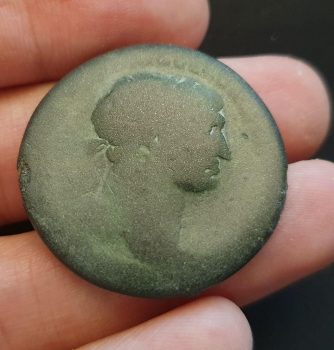Sestertius Traianvs
- Date of discovery: 2024-10-19
- Aproximate location of discovery: Neerlanden, Vlaanderen
- Context: Fragments of terra sigillata, tegulae, imbrex
This Roman sestertius, a large bronze coin used throughout the empire, features on its obverse a laureate and draped bust of Trajan facing right. The reverse presents the goddess Ceres, draped and standing left, holding two ears of corn over a modius (a grain measure), and a tall, vertical torch in her left hand. The iconography reflects themes of agricultural abundance, divine favor, and imperial beneficence.
Trajan (reigned 98–117 CE) was one of Rome’s most celebrated emperors. Born in Hispania (modern Spain), he was the first emperor of provincial origin and is best remembered for his military conquests, including the annexation of Dacia (modern-day Romania), and for vast public building projects in Rome. His reign is often seen as the apex of Roman imperial expansion, prosperity, and civic virtue.
Trajan ruled during a time of relative peace and extraordinary building activity. The empire reached its territorial peak under his command, and his domestic policies aimed at public welfare, including grain distribution programs and infrastructure development. Coins like this one served not just as currency but as circulating endorsements of the emperor’s role as provider and protector of Rome’s well-being.
Thus, this sestertius is more than a piece of ancient currency, it is a public affirmation of imperial responsibility, divine favor, and the ideological link between ruler, gods, and the Roman people.
